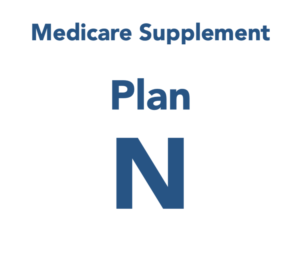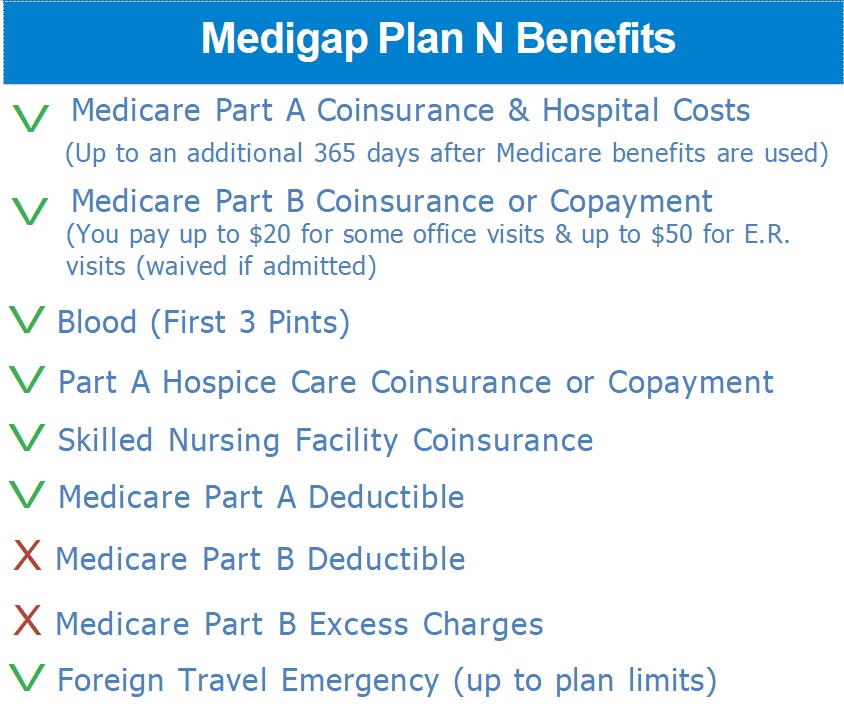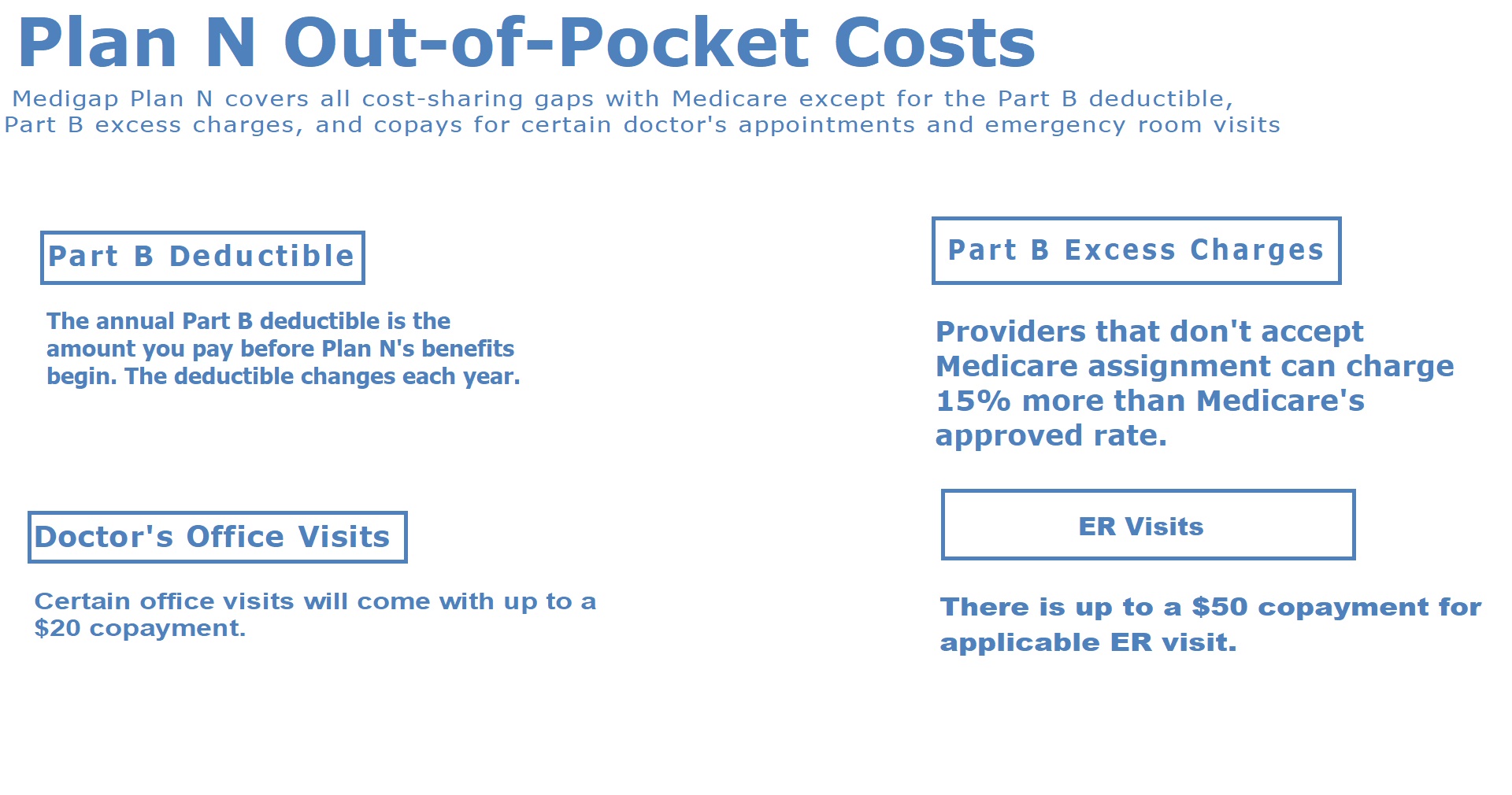 Medicare Plan N is a popular supplemental policy known for its lower premiums. With Plan N, you are responsible for paying the Part B deductible, excess charges, and some copays for doctor and emergency visits. Introduced in 2010, this option, also known as Medigap Plan N, appeals to consumers who prefer lower premiums in exchange for a small annual deductible and copayments.
Medicare Plan N is a popular supplemental policy known for its lower premiums. With Plan N, you are responsible for paying the Part B deductible, excess charges, and some copays for doctor and emergency visits. Introduced in 2010, this option, also known as Medigap Plan N, appeals to consumers who prefer lower premiums in exchange for a small annual deductible and copayments.
All Medicare Supplement Plan N policies are standardized, regardless of the insurance company you choose. Plan N is offered by various well-known insurance companies in many states.
According to a survey by AHIP, Plan N enrollment increased by 20% from 2014 to 2017. With Plan F no longer available for most individuals, Plan N has quickly become the second most popular Medigap plan, following Plan G.
While some may refer to it as Part N, the correct term is Plan N. Medicare has parts, but when discussing supplemental insurance, it is referred to as Plans. Here is a visual representation of what Medicare Supplement Plan N covers and what expenses you are responsible for.

What Does Plan N Cover?
The standardized Medicare Supplement N covers the 20% that Medicare Part B does not cover. Additionally, it takes care of your hospital deductible and all hospital costs. However, please note that you will still be responsible for Part B excess charges, the Part B deductible, as well as some small copays at the doctor’s office and the emergency room.
Medicare ensures that your standard preventive care is fully covered, meaning you won’t have to pay anything for these essential services. With Plan N, you can also benefit from coverage for preventive services such as cancer and diabetes screenings, as well as cardiovascular condition screenings. Additionally, annual physicals, colonoscopies, vaccines, and various other tests are included in the preventive services covered by this plan.
Moreover, your Medicare Supplement Plan N coverage extends to visits to the doctor for injuries and illnesses, durable medical equipment, ambulance services, surgeries, home health care, lab work, imaging tests, diabetes supplies, and many other services. It’s important to note that if Medicare Part A or B covers a particular service, your Supplement plan will also cover it. Medicare will initially pay 80% of the bill and then forward it to your Medigap plan.
In the event that your doctor does not accept Medicare assignment, you may be subject to a 15% excess charge.
At the Hospital?
Medicare Supplemental Plan N offers comprehensive coverage for hospital services. It covers the Part A Hospital deductible, which is currently $1,632 in 2024, as well as the coinsurance of 20%. In addition, Plan N provides an additional year of hospital benefits after Medicare’s coverage ends, ensuring you have extended coverage when you need it most. It also includes coinsurance for hospice care at any certified hospice center and coverage for the first 3 pints of blood. Moreover, Plan N offers foreign travel emergency benefits up to the plan’s limit, providing peace of mind even when you’re abroad.
Plan N Costs
Medicare Supplement Plan N provides similar basic benefits as the popular Plan G, but it requires you to contribute towards certain expenses that are not covered by Plan G. Firstly, you will be responsible for the modest annual Part B deductible ($240 in 2024). Additionally, you will have to pay co-payments of up to $20 for doctor visits, and a $50 copay for emergency room visits.
Furthermore, individuals enrolled in Medigap N may also encounter excess charges from certain medical providers. These providers can bill up to 15% more than what Medicare allows, which is known as an excess charge. Unlike Plan F or G, Plan N does not cover these charges for you. As a result, you may occasionally receive small bills for these excess charges.
 You have the option to prevent Part B excess charges by inquiring with your healthcare providers beforehand about their acceptance of Medicare assignment. If they do accept it, you won’t have to be concerned about excess charges. Alternatively, you can compare Medicare Plan N with Plan G. Many individuals who enroll in Plan N also consider Plan G as an alternative because it is only slightly more costly. The main distinction is that Plan G covers the small copays and excess charges, resulting in fewer bills arriving in your mailbox.
You have the option to prevent Part B excess charges by inquiring with your healthcare providers beforehand about their acceptance of Medicare assignment. If they do accept it, you won’t have to be concerned about excess charges. Alternatively, you can compare Medicare Plan N with Plan G. Many individuals who enroll in Plan N also consider Plan G as an alternative because it is only slightly more costly. The main distinction is that Plan G covers the small copays and excess charges, resulting in fewer bills arriving in your mailbox.
Plan N Example :
Jeff informed his agent that he only goes to the doctor once or twice a year, so he doesn’t think he needs a full coverage Plan F. His agent suggested considering Plan N, which has premiums around 30% lower than Medigap F, but requires copays for certain services.
Under Medicare Supplement Plan N, the hospital deductible for inpatient care is fully covered. However, for outpatient care, Jeff would need to pay the Part B deductible ($240 in 2024) during her first doctor visit of the year. He would also have to pay a copayment of up to $20 for subsequent visits to his physicians. Additionally, there may be an excess charge if his doctor does not participate in Medicare.
For example, if Jeff sees his podiatrist in the middle of the year after meeting his deductible, and the assigned rate for the visit is $100, he would owe a $20 copay. The remaining approved charges would be covered by his Supplement.
If Jeff finds the concept of excess charges and copays confusing but still prefers lower premiums, he could explore Plan G. With Plan G, excess charges are included in the Medigap coverage, and cost-sharing is limited to the Part B deductible only.
Plan N Eligibility
To be eligible for enrollment in Plan N, it is necessary to have both Medicare Parts A and B, and reside within the plan’s service area. The ideal time to enroll in Medicare Plan N is during your Medigap Open Enrollment Period, which commences from the effective date of your Part B coverage. This six-month timeframe provides a unique opportunity to enroll in any Medigap plan without undergoing health underwriting. Regardless of your health conditions, no insurance company can reject your application during this period. If you have missed your one-time Medigap Open Enrollment Period, you still have the option to apply for a Medigap Plan N. We can assess the health-related inquiries on different insurance company’s applications to determine if you meet the requirements.
Frequently Asked Questions
How much does Plan N cost?
Plan N offers a flexible premium structure, varying between $85 and $200. The actual premium amount is determined by various factors, including zip code, gender, age, tobacco usage, and more. To identify the most cost-effective carrier, it is advisable to consult a Medicare broker who can provide a comprehensive comparison.
What is the deductible for Plan N?
The Part B annual deductible for Plan N in 2024 is $240, which you are required to pay. This deductible is one expense that Plan N does not include coverage for.
Difference between Plan G and Plan N?
Plan N has a higher out-of-pocket cost compared to Plan G, however, the premium for Plan N is generally lower. When you choose Plan N, you will be responsible for copays of up to $20 for office visits and up to $50 for ER visits. The most cost-effective plan for you will depend entirely on your individual needs and lifestyle.
Switching from Plan N to Plan G.
Switching from Plan N to Plan G is possible at any time throughout the year. However, if you find yourself outside the 6-month Open Enrollment window, you may be required to provide answers to health-related questions in order to proceed with the switch. It is important to note that approval is not guaranteed in this case.
Plan N vs. G?
Plan N is highly attractive due to its tendency to offer lower premiums compared to Plan G. This particular plan is an excellent choice for individuals who do not frequently visit the doctor. However, it is important to consider that there will be additional out-of-pocket expenses in the form of copays and Part B excess charges. It is crucial to select the plan that aligns perfectly with your specific requirements and financial situation, as the ideal plan will vary from person to person.
Takeaways
All insurance companies that offer Medigap Plan N are required to offer identical coverage, however, the premium rates may differ between carriers. You may encounter copays of up to $20 for office visits and up to $50 for ER visits after meeting the Part B deductible. Opting for Plan N could be a more economical choice compared to Plan G if you rarely visit the doctor.
 Mario Arce
Mario Arce
I have been working with Medicare clients since 2016. I serve California members in San Bernardino & Riverside county.


